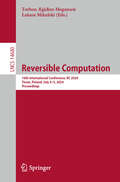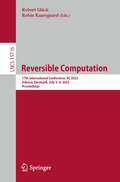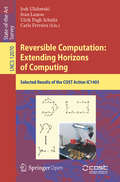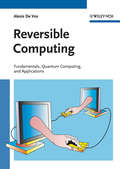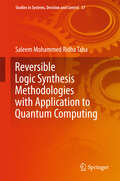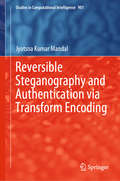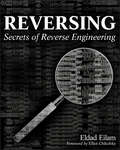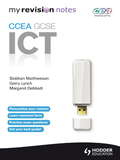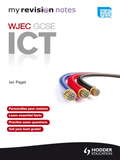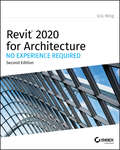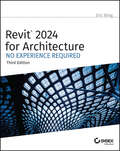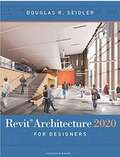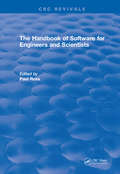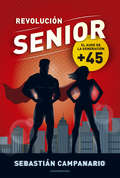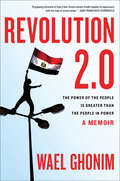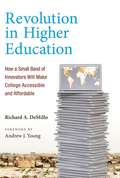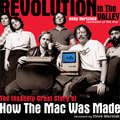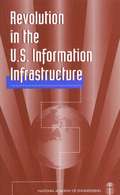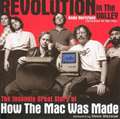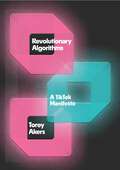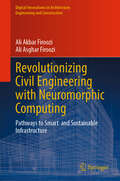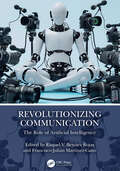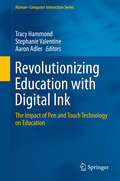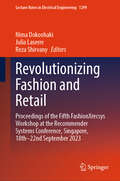- Table View
- List View
Reversible Computation: 16th International Conference, RC 2024, Toruń, Poland, July 4–5, 2024, Proceedings (Lecture Notes in Computer Science #14680)
by Torben Ægidius Mogensen Łukasz MikulskiThis book constitutes the refereed proceedings of the 16th International Conference on Reversible Computation, RC 2024, held in Toruń, Poland, during July 4–5, 2024. The 10 full papers and 3 short papers included along with two invited papers in this book were carefully reviewed and selected from 18 submissions. They were organized in topical sections as follows: Models of Reversible Computation; Experiments in Reversible Programming; Reversible and Quantum Programming Languages; and Synthesis, Verification, and Analysis of Reversible and Quantum Systems.
Reversible Computation: 17th International Conference, RC 2025, Odense, Denmark, July 3–4, 2025, Proceedings (Lecture Notes in Computer Science #15716)
by Robert Glück Robin KaarsgaardThis book constitutes the refereed proceedings of the 17th International Conference on Reversible Computation, RC 2025, held in Odense, Denmark, during July 3–4, 2025. The 7 full papers and 5 short papers included in this book were carefully reviewed and selected from 22 submissions.The conference brought together researchers from computer science, mathematics, engineering, and physics to discuss new developments and directions for future research in the area of Reversible Computation.
Reversible Computation: Selected Results of the COST Action IC1405 (Lecture Notes in Computer Science #12070)
by Ivan Lanese Irek Ulidowski Ulrik Pagh Schultz Carla FerreiraThis open access State-of-the-Art Survey presents the main recent scientific outcomes in the area of reversible computation, focusing on those that have emerged during COST Action IC1405 "Reversible Computation - Extending Horizons of Computing", a European research network that operated from May 2015 to April 2019.Reversible computation is a new paradigm that extends the traditional forwards-only mode of computation with the ability to execute in reverse, so that computation can run backwards as easily and naturally as forwards. It aims to deliver novel computing devices and software, and to enhance existing systems by equipping them with reversibility. There are many potential applications of reversible computation, including languages and software tools for reliable and recovery-oriented distributed systems and revolutionary reversible logic gates and circuits, but they can only be realized and have lasting effect if conceptual and firm theoretical foundations are established first.
Reversible Computing
by Alexis De VosWritten by one of the few top internationally recognized experts in the field, this book concentrates on those topics that will remain fundamental, such as low power computing, reversible programming languages, and applications in thermodynamics. It describes reversible computing from various points of view: Boolean algebra, group theory, logic circuits, low-power electronics, communication, software, quantum computing. It is this multidisciplinary approach that makes it unique.Backed by numerous examples, this is useful for all levels of the scientific and academic community, from undergraduates to established academics.
Reversible Logic Synthesis Methodologies with Application to Quantum Computing
by Saleem Mohammed Ridha TahaThis book opens the door to a new interesting and ambitious world of reversible and quantum computing research. It presents the state of the art required to travel around that world safely. Top world universities, companies and government institutions are in a race of developing new methodologies, algorithms and circuits on reversible logic, quantum logic, reversible and quantum computing and nano-technologies. In this book, twelve reversible logic synthesis methodologies are presented for the first time in a single literature with some new proposals. Also, the sequential reversible logic circuitries are discussed for the first time in a book. Reversible logic plays an important role in quantum computing. Any progress in the domain of reversible logic can be directly applied to quantum logic. One of the goals of this book is to show the application of reversible logic in quantum computing. A new implementation of wavelet and multiwavelet transforms using quantum computing is performed for this purpose. Researchers in academia or industry and graduate students, who work in logic synthesis, quantum computing, nano-technology, and low power VLSI circuit design, will be interested in this book.
Reversible Steganography and Authentication via Transform Encoding (Studies in Computational Intelligence #901)
by Jyotsna Kumar MandalThis book focuses on reversible steganography and authentication via transform encoding, fully discussing in detail the reversibility computation of six transformation techniques: DFT, DCT, wavelets, Z, binomial and grouplet, as well as chaos-based authentication. The book also describes algorithmic approaches based on all transformations along with implementation details and results. Further topics include embedding and extraction into the spatial domain, tuning using GA-based approaches and embedding into imaginary coefficients of the Z domain. Featuring detailed algorithms for encryption and descriptions of all techniques, including embedding techniques for all transform-based steganographic processes, the book also explores the adjustment of pixel values after embedding and presents numerical examples of reversible computations. In the context of chaos-based authentication, it also describes testing the quality of generator is using Monobit, Serial and Poker tests. The book then outlines 15 test cases recommended by NIST fifteen test cases, along with their implementation on six evolutionary algorithms for neural cryptographic systems in the context of wireless computations – TPM, KSOMSCT, DHLPSCT, CHDLPSCT, CTHLPSCT and CGTHLPSCT – and verifies their satisfiability based on the implementations of these six techniques. Lastly it presents various metrics of image processing systems. This book is a valuable reference resource for research scholars, PG/UG students and practicing engineers
Reversing
by Eldad EilamBeginning with a basic primer on reverse engineering-including computer internals, operating systems, and assembly language-and then discussing the variousapplications of reverse engineering, this book provides readers with practical, in-depth techniques for software reverse engineering. The book is broken into two parts, the first deals with security-related reverse engineering and the second explores the more practical aspects of reverse engineering. In addition, the author explains how to reverse engineer a third-party software library to improve interfacing and how to reverse engineer a competitor's software to build a better product.* The first popular book to show how software reverse engineering can help defend against security threats, speed up development, and unlock the secrets of competitive products* Helps developers plug security holes by demonstrating how hackers exploit reverse engineering techniques to crack copy-protection schemes and identify software targets for viruses and other malware* Offers a primer on advanced reverse-engineering, delving into "disassembly"-code-level reverse engineering-and explaining how to decipher assembly language
Revision Notes: CCEA ICT for GCSE (My Revision Notes (PDF))
by Siobhan Matthewson Gerry Lynch Margaret DebbadiRevision Notes: CCEA ICT for GCSE has been written by experienced teachers and examiners so that you can be confident that it covers only the facts and ideas you will be expected to recall and use in the exam.- Essential facts are carefully organised to make revising easier.- Exams tips show you how to avoid losing marks and get the best grade.- Check your understanding questions support you in the run-up to the exams, with answers provided free online at www.hodderplus.co.uk.This book will help you plan and pace your revision to suit your learning needs and can be integrated with other revision techniques you are using.
Revision Notes: WJEC ICT for GCSE
by Ian PagetMy Revision Notes: WJEC ICT for GCSE has been written by experienced teachers and examiners so that you can be confident that it covers only the facts and ideas you will be expected to recall and use in the exam.Essential facts are carefully organised to make revising easier.Exams tips show you how to avoid losing marks and get the best grade.Check your understanding questions support you in the run-up to the exams, with answers provided free online at www.hodderplus.co.uk.This book will help you plan and pace your revision to suit your learning needs and can be integrated with other revision techniques you are using.
Revit 2020 for Architecture: No Experience Required
by Eric WingThe updated 2020 edition of the popular step-by-step tutorial for Revit Architecture Shortly after its first publication, Autodesk Revit for Architecture: No Experience Required quickly became the market-leading, real-world guide for learning and building with Revit—the powerful and sophisticated Building Information Modeling (BIM) software used by professionals the world over. Fully updated for Revit 2020, this popular, user-friendly book helps you learn the Revit interface, understand the fundamental concepts and features of the software, and design, document, and present a 3D BIM project. A continuous, step-by-step tutorial guides you through every phase of the project: from placing walls, doors, windows, structural elements, dimensions, and text, to generating documentation, advanced detailing, site grading, construction scheduling, material takeoffs, and much more. Updated and revised to include new content, this invaluable guide covers all the fundamental skills every Revit user needs. Whether used as a complete, start-to-finish lesson or as a quick-reference for unfamiliar tasks, this book will help you: Learn each phase of designing, documenting, and presenting a four-story office building using a simple yet engaging continuous tutorial Follow the tutorial sequentially or jump to any chapter by downloading the project files from the Sybex website Use the start-to-finish tutorial project as a reference for your own real-world projects and to develop a powerful Revit skillset Gain thorough knowledge of Revit’s essential concepts and features to make the move from 2D drafting to 3D building information modeling Get up to speed with advanced features, including new coverage of advanced walls, families, sites, topography, and more Autodesk Revit 2020 for Architecture No Experience Required is the go-to guide for both professionals and students seeking to learn Revit's essential functions quickly and effectively, to understand real workplace projects, processes, and workflows, and to set the stage for continuing on to more advanced skills.
Revit 2024 for Architecture: No Experience Required
by Eric WingThe latest and most authoritative version of the popular step-by-step tutorial for Revit Architecture The newly revised third edition of Revit 2024 for Architecture: No Experience Required is the latest update to the market-leading, real-world guide for learning and building with Revit—the powerful and sophisticated Building Information Modeling (BIM) software used by professionals around the world. This popular, user-friendly book teaches you the Revit interface and helps you understand the foundational concepts and features of the software. You’ll learn to design, document, and present a 3D BIM project with a continuous, step-by-step tutorial that guides you through every phase of the project: from placing walls, doors, windows, structural elements, dimensions, and text, to generating documentation, advanced detailing, site grading, construction scheduling, material takeoffs, and more. In addition, this book helps you prepare for the Autodesk Revit Architecture Certification Exam. Throughout the book, you will find helpful insights directly related to the exam. The last two chapters are dedicated entirely to the exam with a practice test at the end of the book. You’ll also: Learn each phase of designing, documenting, and presenting a four-story office building using a simple yet engaging continuous tutorial Follow the tutorial sequentially or jump to any chapter by downloading the project files from the Sybex website Use the start-to-finish tutorial project as a reference for your own real-world projects and to develop a powerful Revit skillset Gain thorough knowledge of Revit’s essential concepts and features to make the move from 2D drafting to 3D building information modeling Get up to speed with advanced features, including new coverage of advanced walls, families, sites, topography, and moreThe Autodesk Revit 2024 for Architecture: No Experience Required, 3rd Edition, is the go-to guide for professionals and students seeking to learn Revit’s essential functions quickly and effectively.
Revit Architecture 2020 for Designers
by Douglas R. SeidlerBuilding information modeling (BIM) is rapidly replacing AutoCAD as the digital drawing tool of choice for architect and interior designers-and Revit ® Architecture is the leading software package in the BIM marketplace. Neither simplistic nor exhaustive, Revit ® Architecture 2020 for Designers is written specifically for architects and interior designers learning digital drawing for the first time or transitioning from CAD to BIM. <p><p>Beginning with the building blocks of BIM (levels, walls, windows, and doors), the book progresses through in-depth instructions to create both presentation drawings and construction documents. Advanced features are also covered such as custom families, photorealistic rendering, custom title blocks, and exporting drawings to AutoCAD ® and SketchUp. <p><p>Instructions are fully illustrated, creating smooth transition to the BIM environment for all designers. Clear, concise, and above all visual, this is the Revit guide written specifically for interior designers and architects.
Revival: The Handbook of Software for Engineers and Scientists (CRC Press Revivals)
by Paul W RossThe Handbook of Software for Engineers and Scientists is a single-volume, ready reference for the practicing engineer and scientist in industry, government, and academia as well as the novice computer user. It provides the most up-to-date information in a variety of areas such as common platforms and operating systems, applications programs, networking, and many other problem-solving tools necessary to effectively use computers on a daily basis.Specific platforms and environments thoroughly discussed include MS-DOS®, Microsoft® Windows™, the Macintosh® and its various systems, UNIX™, DEC VAX™, IBM® mainframes, OS/2®, Windows™ NT, and NeXTSTEP™. Word processing, desktop publishing, spreadsheets, databases, integrated packages, computer presentation systems, groupware, and a number of useful utilities are also covered. Several extensive sections in the book are devoted to mathematical and statistical software. Information is provided on circuits and control simulation programs, finite element tools, and solid modeling tools.
Revolución senior: El auge de la generación + 45
by Sebastián CampanarioSebastián Campanario cuenta de qué modo los +45 tendrán un lugar protagónico en los próximos años. Una propuesta original y disruptiva, que da las claves para deconstruir nuestros prejuicios etarios y entender los huracanes de cambio que estamos atravesando. ¿Solo los jóvenes son creativos e innovadores? ¿Qué podrían hacer las empresas y los gobiernos para dejar de ver los años como un problema y aprovechar su potencial económico? ¿A qué edad, realmente, uno considera que los demás son viejos? Así como sucedió con el debate de género, crece la conciencia sobre el estigma de valores negativos atribuidos a la vida adulta. El advenimiento de los primeros millennials cincuentones no está lejos, así que las economías se están replanteando su relación con los mayores de esa edad. Sebastián Campanario cuenta de qué modo los +45 tendrán un lugar protagónico en los próximos años, y da las claves para deconstruir nuestros prejuicios etarios y entender los huracanes de cambio que estamos atravesando. Mitos, estadísticas y testimonios en torno a la generación senior en la era de la inteligencia adaptativa. Paso a paso, cómo será "el contraataque de los clásicos", en uno de los libros más disruptivos y originales.
Revolution 2.0: The Power of the People Is Greater Than the People in Power, A Memoir (Playaway Adult Nonfiction Ser.)
by Wael GhonimThe former Google executive and political activist tells the story of the Egyptian revolution he helped ignite through the power of social media. In the summer of 2010, thirty-year-old Google executive Wael Ghonim anonymously launched a Facebook page to protest the death of an Egyptian man at the hands of security forces. The page&’s following expanded quickly and moved from online protests to a nonconfrontational movement. On January 25, 2011, Tahrir Square resounded with calls for change. Yet just as the revolution began in earnest, Ghonim was captured and held for twelve days of brutal interrogation. After he was released, he gave a tearful speech on national television, and the protests grew more intense. Four days later, the president of Egypt was gone. In this riveting story, Ghonim takes us inside the movement and shares the keys to unleashing the power of crowds in the age of social networking. &“A gripping chronicle of how a fear-frozen society finally topples its oppressors with the help of social media.&” —San Francisco Chronicle &“Revolution 2.0 excels in chronicling the roiling tension in the months before the uprising, the careful organization required and the momentum it unleashed.&” —NPR.org
Revolution in Higher Education
by Richard A. DemilloColleges and universities have become increasingly costly, and, except for a handful of highly selective, elite institutions, unresponsive to twenty-first-century needs. But for the past few years, technology-fueled innovation has begun to transform higher education, introducing new ways to disseminate knowledge and better ways to learn -- all at lower cost. In this impassioned account, Richard DeMillo tells the behind-the-scenes story of these pioneering efforts and offers a roadmap for transforming higher education. Building on his earlier book, Abelard to Apple, DeMillo argues that the current system of higher education is clearly unsustainable. Colleges and universities are in financial crisis. Tuition rises inexorably. Graduates of reputable schools often fail to learn basic skills, and many cannot find suitable jobs. Meanwhile, student-loan default rates have soared while the elite Ivy and near-Ivy schools seem remote and irrelevant. Where are the revolutionaries who can save higher education? DeMillo's heroes are a small band of innovators who are bringing the revolution in technology to colleges and universities. DeMillo chronicles, among other things, the invention of MOOCs (Massive Open Online Courses) by professors at Stanford and MIT; Salman Khan's Khan Academy; the use of technology by struggling historically black colleges and universities to make learning more accessible; and the latest research on learning and the brain. He describes the revolution's goals and the entrenched hierarchical system it aims to overthrow; and he reframes the nature of the contract between society and its universities. The new institutions of a transformed higher education promise to demonstrate not only that education has value but also that it has values -- virtues for the common good.
Revolution in The Valley [Paperback]: The Insanely Great Story of How the Mac Was Made
by Andy HertzfeldThere was a time, not too long ago, when the typewriter and notebook ruled, and the computer as an everyday tool was simply a vision. Revolution in the Valley traces this vision back to its earliest roots: the hallways and backrooms of Apple, where the groundbreaking Macintosh computer was born. The book traces the development of the Macintosh, from its inception as an underground skunkworks project in 1979 to its triumphant introduction in 1984 and beyond.The stories in Revolution in the Valley come on extremely good authority. That's because author Andy Hertzfeld was a core member of the team that built the Macintosh system software, and a key creator of the Mac's radically new user interface software. One of the chosen few who worked with the mercurial Steve Jobs, you might call him the ultimate insider.When Revolution in the Valley begins, Hertzfeld is working on Apple's first attempt at a low-cost, consumer-oriented computer: the Apple II. He sees that Steve Jobs is luring some of the company's most brilliant innovators to work on a tiny research effort the Macintosh. Hertzfeld manages to make his way onto the Macintosh research team, and the rest is history.Through lavish illustrations, period photos, and Hertzfeld's vivid first-hand accounts, Revolution in the Valley reveals what it was like to be there at the birth of the personal computer revolution. The story comes to life through the book's portrait of the talented and often eccentric characters who made up the Macintosh team. Now, over 20 years later, millions of people are benefiting from the technical achievements of this determined and brilliant group of people.
Revolution in the U.S. Information Infrastructure
by National Academy of Engineering StaffWhile societies have always had information infrastructures, the power and reach of today's information technologies offer opportunities to transform work and family lives in an unprecedented fashion. This volume, a collection of six papers presented at the 1994 National Academy of Engineering Meeting Technical Session, presents a range of views on the subject of the revolution in the U.S. information infrastructure. The papers cover a variety of current issues including an overview of the technological developments driving the evolution of information infrastructures and where they will lead; the development of the Internet, particularly the government's role in its evolution; the impact of regulatory reform and antitrust enforcement on the telecommunications revolution; and perspectives from the computer, wireless, and satellite communications industries.
Revolution in the Valley: The Insanely Great Story of How the Mac Was Made
by Andy HertzfeldThere was a time, not too long ago, when the typewriter and notebook ruled, and the computer as an everyday tool was simply a vision. Revolution in the Valley traces this vision back to its earliest roots: the hallways and backrooms of Apple, where the groundbreaking Macintosh computer was born. The book traces the development of the Macintosh, from its inception as an underground skunkworks project in 1979 to its triumphant introduction in 1984 and beyond. The stories in Revolution in the Valley come on extremely good authority. That's because author Andy Hertzfeld was a core member of the team that built the Macintosh system software, and a key creator of the Mac's radically new user interface software. One of the chosen few who worked with the mercurial Steve Jobs, you might call him the ultimate insider. When Revolution in the Valley begins, Hertzfeld is working on Apple's first attempt at a low-cost, consumer-oriented computer: the Apple II. He sees that Steve Jobs is luring some of the company's most brilliant innovators to work on a tiny research effort the Macintosh. Hertzfeld manages to make his way onto the Macintosh research team, and the rest is history. Through lavish illustrations, period photos (many never before published), and Hertzfeld's vivid first-hand accounts, Revolution in the Valley reveals what it was like to be there at the birth of the personal computer revolution. The story comes to life through the book's portrait of the talented and often eccentric characters who made up the Macintosh team. Now, over 20 years later, millions of people are benefiting from the technical achievements of this determined and brilliant group of people.
Revolutionary Algorithms: A TikTok Manifesto
by Torey AkersFrom an artist and TikTok creator, a critical look at the controversial app and its effect on cultural heritage, artificial intelligence, community organizing, and digital censorship. In Revolutionary Algorithms, Torey Akers approaches TikTok with a deep understanding of the app, as both a prolific creator and consumer of its content. In these essays, she interrogates how the TikTok ban and the multiple genocides happening around the world are deeply intertwined; how the app can empower creators, amplify social movements, and document abuses of power. She addresses the good, bad, and sometimes uncanny parts of maneuvering and communicating in a digital space. As a new era of social media looms, Akers makes the case for techno-progressivism, looking toward a future where TikTok continues to connect, inspire, and create space for more intersectionality, equity, and joy.
Revolutionen bortom 140 tecken: Myten om Twitter-revolutionen
by Mariam Kirollos"Om det är något som givit denna revolution kraft så är det martyrernas blod, och det enorma antal människor som är beredda att dö för en nations frihet." Sociala medier framhölls under den Arabiska våren av många som en drivande kraft i revolutionen, det var de "sociala mediernas revolution". Men i Egypten hade bara 25% av befolkningen tillgång till internet och endast 1,5 promille använde Twitter. Tvärtemot västerländsk medias framställning så ansåg många revolutionärer att Twittervärlden var helt isolerad från den egyptiska gatan. Twitter-revolutionen är en myt. Egyptiska Mariam Kirollos är politisk aktivist, doktorand och människorättsförsvarare som har varit mycket engagerad i den egyptiska revolutionen. Denna text publicerades ursprungligen i antologin "Myten om internet" (Volante, 2012).
Revolutionizing Civil Engineering with Neuromorphic Computing: Pathways to Smart and Sustainable Infrastructure (Digital Innovations in Architecture, Engineering and Construction)
by Ali Akbar Firoozi Ali Asghar FirooziThis book delves into the transformative potential of neuromorphic computing within the realm of civil engineering, emphasizing its role in advancing smart infrastructure systems. Neuromorphic computing, inspired by the neural structures of the human brain, offers unparalleled efficiencies in processing complex, dynamic data sets, thereby facilitating real time decision-making and predictive analytics in infrastructure management. Through a comprehensive exploration of emerging circuits, memory technologies, intelligent learning algorithms, and application-driven systems, it illustrates how neuromorphic computing can significantly enhance the resilience, efficiency, and sustainability of urban infrastructure. The book further addresses the challenges, ethical considerations, and future directions associated with the integration of these advanced technologies into civil engineering projects. Through detailed case studies, it provides insights into successful implementation strategies, risk management, and contingency planning, underscoring the importance of ethical design and development. This book serves as a valuable resource for practitioners, researchers, and policymakers involved in the evolution of civil engineering toward smarter, more responsive, and sustainable urban environments.
Revolutionizing Communication: The Role of Artificial Intelligence
by Benítez Rojas, Raquel V. Martínez-Cano, Francisco-JuliánRevolutionizing Communication: The Role of Artificial Intelligence explores the wide-ranging effects of artificial intelligence (AI) on how we connect and communicate, changing social interactions, relationships, and the very structure of our society. Through insightful analysis, practical examples, and knowledgeable perspectives, the book examines chatbots, virtual assistants, natural language processing, and more. It shows how these technologies have a significant impact on cultural productions, business, education, ethics, advertising, media, journalism, and interpersonal interactions.Revolutionizing Communication is a guide to comprehending the present and future of communication in the era of AI. It provides invaluable insights for professionals, academics, and everyone interested in the significant changes occurring in our digital age.
Revolutionizing Education with Digital Ink
by Aaron Adler Tracy Hammond Stephanie ValentineDerived from contributions to the Workshop on Pen and TouchTechnology on Education (WIPTTE) in 2015, this edited volume highlights recentdevelopments for pen and tablet research within the education system with aparticular focus on hardware and software developments, comprising theperspectives of teachers, school and university administrators, and researchersfor educators at every level. Split into six distinct parts, the book explores topics like howclassrooms are increasingly using sketch-based videos, created by teachers andstudents alike, and how the teaching of key skills such as literacy, languages,math, and art via pen and touch technologies within the classroom are leadingto improvements in engagement, learning, and retention levels amongst students. Future perspectives of digital learning, as envisioned by current high schoolstudents, are also explored. Revolutionizing Education with Digital Inkis a must-read for those seeking to understand the direction of current andfuture pen and touch research, its current use in classrooms, and futureresearch directions.
Revolutionizing Fashion and Retail: Proceedings of the Fifth fashionXrecsys Workshop at the Recommender Systems Conference, Singapore, 18th-22nd September 2023 (Lecture Notes in Electrical Engineering #1299)
by Nima Dokoohaki Reza Shirvany Julia LaserreThis book presents the proceedings from the Fifth Workshop on Recommender Systems in Fashion and Retail (2023), highlighting the latest advances in AI-driven technologies for e-commerce, retail, and fashion. With contributions from leading academic and industry researchers, it explores how AI-powered recommender systems address key challenges and enable innovations in personalization and beauty, size and fit recommendations, and helping brands deliver more tailored and engaging shopping experiences.
